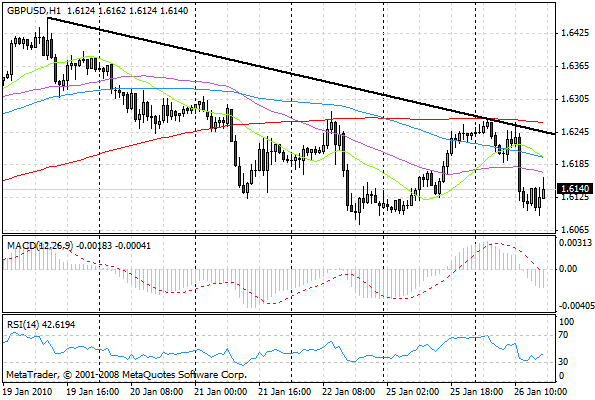Source: ForexYard
The Dollar experienced mix trading yesterday, climbing against the Yen but falling against the EUR with traders anticipating both Japanese and U.S. interest rate decisions and a bloc of economic data. The economic releases to come may be a positive for the USD.
Economic News
USD – Existing Home Sales Fall Sharply
Yesterday’s release of U.S. existing home sales showed a sharp drop during the month of December. Traders reacted by selling the Dollar and buying the EUR instead. However, by the end of the day, the EUR/USD was relatively unchanged from its opening price as traders are tentative to place large bets on the direction of currencies before the release of both Japanese and American interest rate decisions.
Near the end of the day, the EUR/USD was trading at 1.4155 from an opening price of 1.4166. The Cable was at 1.6245, after starting the day at 1.6111.
The large amount of economic news and data releases that are expected this week is causing trader hesitation. Perhaps the most important event will be the release of the Federal Open Market Committee Statement on Wednesday. Economists are expecting the Fed to hold interest rates steady and to continue with the same language regarding interest rates staying low for a considerable time period.
Also due to be released today is the CB Consumer Confidence. The survey of household’s opinion typically has a large impact on the daily trend of the EUR/USD. A better than expected reading from the survey could be a boost for the USD, sending the pair lower, to the 1.4040 support line.
EUR – Risk Aversion is back
This year’s trading of the EUR was expected to be driven by a disparity of interest rates between Europe and the U.S., but instead we have seen another side of trading. Risk aversion has crept back into the scene. Slowing economic data, new U.S. banking regulations proposed by the Obama administration, worries over Greece’s financial situation, and now concerns of the Ben Bernanke’s senate confirmation for a second term as Fed chief facing difficulties are some of the highlights that have increased risk aversion in forex trading recently.
For currency traders, this means a continued delay in the return of normal trading trends that were seen before the financial crisis. As we experienced last week, the Dollar rose after risk taking was sucked out of the market by the proposed new banking regulations in the U.S. that would force commercial banks to chose between a traditional banking business model or that of a securities trading firm.
Europe also faces its own risks as well surrounding the financial stability of not only Greece but also Portugal and Italy. Spreads on Greek government bonds eased yesterday from their record high on Friday, but the market feels Greece is a liability for the European Union increasing negative sentiment and pressure on the EUR.
Today’s release of the German Ifo Business Climate may be a good indicator of how businesses view the state of the Euro-Zone economy. Another key data release will be the Preliminary GDP from England. This data will help to set the tone for this week’s trading and should be followed carefully. Positive GDP results could sink the EUR further as the EUR/GBP could fall to the 0.8650 level.
JPY – Market Anticipates Japanese Interest Rate Decision
The USD/JPY traded in a tight range yesterday after the release of negative U.S. existing home sales numbers. However, the pair climbed back after pressure was put on the yen with the market expecting the Bank of Japan (BoJ) will announce today the expansion of its monetary stimulus program. This will be done to counter a situation of falling prices. The threat of deflation has loomed over the Japanese economy. An economic recovery will be made much more difficult as prices decline with consumers choosing to delay big purchases in hopes of further price declines in the future.
Yesterday the pair traded at a high of 90.32 after opening the day at 90.07.
Many traders were tentative to take on new large positions in the Yen before the BoJ press conference that accompanies the interest rate release. We could see a decline in the Yen during today’s trading as the BoJ is expected to hold interest rates steady, but could increase its programs of either emergency lending to Japanese companies or further purchases of Japanese government debentures. This could lead to a weaker Yen with the pair potentially rising to the resistance level of 91.75.
Crude Oil – Spot Crude Oil Prices Rise with U.S. Stocks
Spot Crude Oil traded higher after Monday’s trading session. This puts an end to the 3 consecutive day skid in Crude Oil prices. The commodity climbed higher due to a late day rise in U.S. equities. Crude Oil was trading at $74.90 after opening the day at $74.54. At one point in the day prices dropped to a new month low at $74.02.
Driving prices higher was a late session rally in U.S. equities after the market shrugged off lower than expected existing home sales numbers. Also the assessment of Ben Bernanke’s expected confirmation for a second term as Fed Chairman helped spark a price rally.
Despite the rise in prices today, concerns of future demand still weigh on the market. Last week the Chinese government took steps to slow economic growth in the country. This hurt Crude Oil prices and left spot crude oil prices down 5% for the week.
Technical News
EUR/USD
A breach of the lower Bollinger Band is evident on the hourly and 2 hour charts. Furthermore, the pair’s RSI is floating in the oversold territory on the hourly and daily charts and an impending bullish cross is seen on the hourly chart’s Slow Stochastic. Going long for the day may be a good choice.
GBP/USD
The pair seems to be exhibiting some mixed signals. While the hourly and daily charts’ Slow Stochastic are exhibiting a bullish cross, the 4 hour Slow Stochastic is exhibiting a bearish one and the 2 hour RSI is floating near the overbought territory. Waiting for a clearer direction for the pair may be advised for today.
USD/JPY
The pair may be seeing some correction today as a breach of the lower Bollinger Band is evident on the hourly and 2 hour charts and a bullish cross is exhibited on the daily chart’s Slow Stochastic. Furthermore the daily and hourly RSI are floating near the oversold territory. Going long for the day may be advised.
USD/CHF
A breach of the upper Bollinger Band is evident on the hourly and 2 hour charts while the daily and hourly RSI are floating in the overbought territory. A bearish cross is evident on the hourly Slow Stochastic. Going short for the day may be a good choice.
The Wild Card
USD/NOK
The pair may see a downward correction today as the 8 hour and daily RSI are floating in the overbought territory and a fresh bearish cross is evident on the hourly and daily charts’ Slow Stochastic. There is also a breach of the upper Bollinger Band seen on the hourly, 2 hour and 4 hour charts. Forex traders are advised to go short for today.
Forex Market Analysis provided by Forex Yard.
© 2006 by FxYard Ltd
Disclaimer: Trading Foreign Exchange carries a high level of risk and may not be suitable for all investors. There is a possibility that you could sustain a loss of all of your investment and therefore you should not invest money that you cannot afford to lose. You should be aware of all the risks associated with Foreign Exchange trading.
 fourth quarter level of 2008 after an annual 5.1 percent decrease in the third quarter.
fourth quarter level of 2008 after an annual 5.1 percent decrease in the third quarter.




